Learning Objectives
- Describe how the parts of the eye and ear convert sensory input into the experiences of seeing and hearing
- Describe the major Gestalt principles of perceptual organization
Sensation and Human Potential
You fill up my senses / Like a night in a forest / Like the mountains in springtime / Like a walk in the rain / Like a storm in the desert / Like a sleepy blue ocean/ You fill up my senses/ Come fill me again
Annie’s Song by John Denver
The Importance of Sensation and Perception
Eat, survive, reproduce. Whether one lives in the rainforest or an urban metropolis, survival requires locating and identifying edible foods and avoiding predators. In Chapter 2, we examined how our nervous system evolved to enable us to address these basic survival needs and how our brain evolved to enable us to consider “what’s it all about?” In this chapter, we consider how our nervous system transmits and interprets sensory information, relaying it to parts of the body capable of responding. Sensation refers to the initial detection of a stimulus resulting from the physical stimulation of a receptor in a sense organ (e.g., eye, ear, etc.). Perception refers to the integration and interpretation of sensory information. Often sensation is described as a bottom-up process, starting with stimulation of a sense organ receptor and moving toward the brain. In contrast, perception is often described as being a top-down process since the initial integration and interpretation takes place in the brain. The importance of sensation and perception to individual and species survival is undeniable.
Sensation – Detecting Stimuli
Even very simple organisms possess the ability to sense and respond to environmental stimulation. For example, moths are attracted by light. Aristotle referred to five human senses: seeing, hearing, taste, smell, and touch. Others consider there to be additional senses of temperature (thermoception), pain, muscle tension (kinesthesia), and balance (equilibrium). Each sense responds to a specific type of physical stimulation and possesses specific receptor cells. Figure 3.1 lists the stimulus, sense organ, and receptor for the different senses.
| Sense | Stimulus | Sense Organ | Receptor |
| Vision | Light waves | Eye | Rods and cones of the retina |
| Hearing | Sound waves | Ear | Hair cells of the basilar membrane |
| Taste | Edible substances | Tongue | Taste buds of the tongue epithelium |
| Smell | Odorous molecules | Nose | Smell receptor of the nasal epithelium |
| Touch | Tactile stimulus | Skin | Touch receptors |
| Temperature | Heat and cold | Skin | Thermoceptor of skin |
| Pain | Intense mechanical, thermal, or chemical stimulus | Skin | Pain receptor of skin |
| Balance and muscle tension | Position of muscles, joints, and tendons | Ear, skeletal muscles, joints, tendons | Hair cells of the semicircular canals, nerve endings of the muscles, joints, and tendons |
Figure 3.1 The senses
Evolution of Sensation
Sensory information, to the extent that it accurately represents the environment, improves adaptation (Gaulin & McBurney, 2003). It should not be surprising that sense organs exist in very simple animals or that more than half the human brain is dedicated to the reception and interpretation of sensory information. Vision enables humans as well as less complex organisms (e.g., insects, sea crabs, birds, etc.) to avoid bumping into objects and to identify food sources. Hearing enables animals to detect the presence and location of dangerous or appetitive objects at a distance. Taste and smell enable us to detect potential foods or poisonous substances. Touch and pain indicate the presence of potentially dangerous objects or conditions (Gaulin & McBurney, 2003).
It is possible to study how the human brain evolved to detect, transmit, and interpret sensory information by studying the brains of other animals, especially primates (and particularly monkeys (Kaas, 2008). In comparison to our earlier mammalian ancestors, primate sensory and motor systems are much more complex and divided into a large number of functional units. For example, macaque monkeys possess between 30 and 40 separate cortical areas dedicated to vision and 15 to 20 areas dedicated to hearing. The human brain is approximately 15 times the size of the brain of macaques, possessing approximately 100 billion neurons in comparison to 6.4 billion neurons and over 200 cortical areas. Early primates were small, nocturnal, lived in trees, and ate insects, buds, and fruit. Their eyes were forward-looking and large, implying that vision played an important adaptive role in their survival. The increased number and size of cortical areas dedicated to vision, and increased number of motor areas, enabled coordination of visual information with reaching for and grabbing food while suspended from unsteady tree branches (Kaas, 2008).
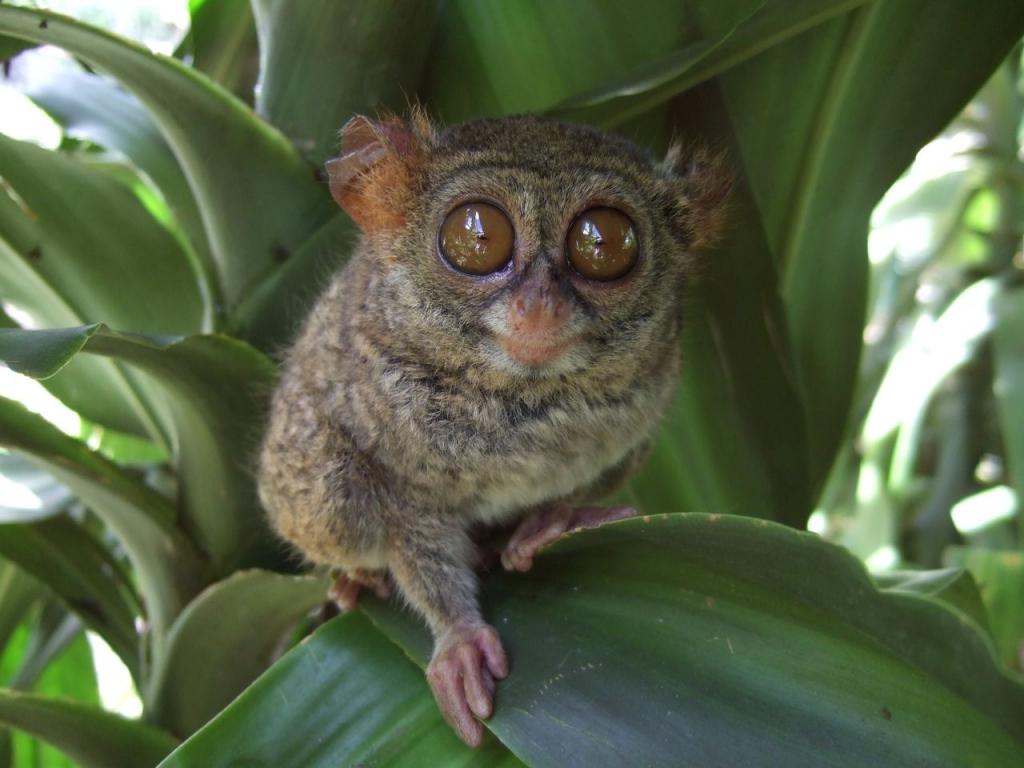
Figure 3.2 Tree dwelling primate
Sensory Thresholds
The first scientific studies of human sensation and perception were conducted at the University of Leipzig where Wundt later established the first psychology laboratory. This earlier research obviously influenced Wundt’s proposed definition, goals, and methods for the discipline. In 1860, Gustav Fechner published the classic “Elements of Psychophysics”, naming the systematic study of the effect of varying the properties of stimuli on sensation and perception. Fechner extended the prior work of Max Weber examining the initial step enabling perception; detecting the presence or change in value of a stimulus. Weber distinguished between these two types of sensory thresholds. An absolute threshold is the minimum intensity of a stimulus required for one to detect its presence. For example, how bright does a light have to be or how loud does a tone have to be for a person to notice it. A difference threshold (often referred to as the “just noticeable difference” or jnd) is the minimum amount of change in intensity required for a person to notice a difference. Fechner replicated Weber’s findings that the amount of change required is a constant fraction of the comparison stimulus. For example, if the constant jnd for length is one-tenth, you would need to increase a 10-inch line by one inch and a 20-inch line by two inches to notice the difference. This relationship is known as “Weber’s Law.”
Adaptation requires detecting changes in one’s environment and behaving in a way which promotes survival. Clearly, one is at a disadvantage if a sense is not functioning optimally. If you ever had your hearing tested, the technician probably used one of the two procedures developed by Weber, the method of limits or the method of constant stimuli. Using the method of limits to determine an absolute threshold, the amplitude (i.e., loudness) of a sound would be gradually increased until you report hearing it. Then the amplitude would be decreased until you report no longer hearing it. This would be repeated several times for different frequencies of sounds, from very low bass to very high treble.
Usually, we think of a single value as determining an absolute or difference threshold. That is, a sound must reach a particular decibel level (loudness) for us to sense its presence. Unfortunately, when testing is conducted, one does not always obtain the same result. This raises the question of how to define what constitutes “the” (apparently not so absolute) threshold? Is it the value where you first report hearing the sound? Or, is it the value where you always report hearing it? Early on, researchers decided to compromise between these two possibilities. The (not so) absolute threshold is defined as the average of the points at which the sounds appeared and disappeared.
A similar process would be followed to determine a difference threshold. In this instance, the technician would start with a sound you could hear and gradually increase the amplitude until you reported it being louder. Then the amplitude would gradually be decreased until you reported it being softer, etc. The jnd would be defined as the average change required for you to report the tone as being louder or softer.
A problem with the method of limits is that people sometimes anticipate hearing a stimulus appear or disappear. In order to address this problem, the method of constant stimuli presents sounds at random amplitudes. Unfortunately, the result frequently changes from trial to trial. That is, in testing for an absolute threshold, sometimes the person will report hearing it and sometimes not. So much for absolutes! Weber defined the absolute threshold as that value which the individual reported hearing 50 percent of the time. Similarly, a jnd was defined as the amount of change required for you to report a difference half the time. These procedures and criteria continue to be used for research and diagnostic applications.
Threshold values change as the result of continual exposure. This phenomenon is called sensory adaptation. With the exception of pain and extremely intense stimulation, the nervous system becomes decreasingly sensitive to prolonged events. For example, if someone holds your hand you stop feeling it after a little while. You quickly adapt to hot showers and to the cold when you jump into a pool of water. The same is true after exposure to perfume or after-shave lotion, or to constant background noise (e.g., the sound of a fan). From an adaptive perspective, it is as though once you have detected the presence of a stimulus it is not essential to maintain the same level of sensitivity.
Vision
Every man takes the limits of his own field of vision for the limits of the world.
Arthur Schopenhauer, Studies in Pessimism (1851).
Whether adapting to the rainforest or a modern city, we rely heavily on vision to survive and enjoy our surroundings. From the time we wake up in the morning to the time we go to bed at night, we almost constantly process and respond to visual information. We move about our surroundings, locating needed substances and objects, constantly assessing achievement of our goals. We fashion and use tools tailored to the demands of our unique environmental niches. Examples include blowpipes in the rain forest and laptops in our schools. No matter where they reside, humans engage in creative arts. Examples include playing flutes and fashioning necklaces in the rainforest; and playing flutes and fashioning necklaces in cities. The more some things change, the more they stay the same! We gaze upon and pay close attention to the appearance of others as we interpret facial expressions and body language in our interpersonal interactions. As expressed by Schopenhauer, our interpretation of our world and life is based upon what we see.
For most of our history on earth, humans experienced daily changes in the amount of light based upon the position of the sun. Only in the light do we experience the beauty of color. Seeing in the dark is a very different and more challenging experience. We will review how our eyes detect and process reflected light to enable color perception, and adapt to different levels of illumination. Transduction refers to the process through which physical stimulation is converted into neurological action potential and transmitted from receptors to higher brain regions for further processing. Figure 3.3 shows the major parts of the eye involved in the transduction process converting light into electronic signals transmitted to the brain. Light reflected from objects enters and undergoes initial focusing as it passes through the transparent cornea. Depending upon darkness or brightness, the iris dilates or closes, controlling the amount of light reaching the lens. The lens changes shape depending upon distance of the object, completing focusing. The remaining focused beam of light reaches photoreceptors lining the surface of the retina. Most of the light reaches the center of the retina, with the fovea being the small focal point with the greatest concentration of photoreceptors. Signals from the photoreceptors travel along nerve fibers to the optic nerve at the back of the eye. From there the signals are transmitted to the occipital lobe of the cerebral cortex.
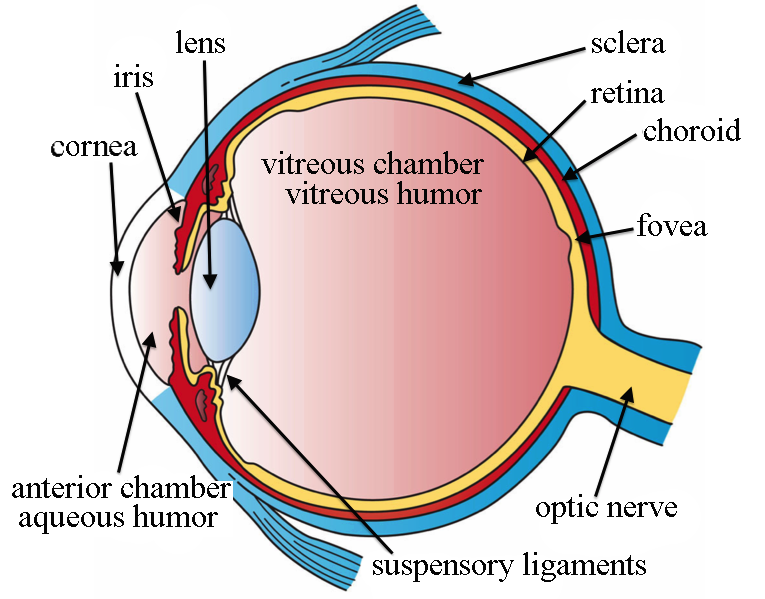
Figure 3.3 The Human Eye
Color Vision
Can you imagine the world without color? Figures 3.4and 3.5 demonstrate not only the beauty which would be missing, but also the amount of potentially adaptive information. It is far easier to identify similarities and differences or look for a particular feature with the added dimension of color. This is even true for the birds and the bees, both of which possess excellent color vision. Clearly this ability is valuable from an adaptive evolutionary perspective.


Figures 3.4 and 3.5 The birds the bees
The psychophysics of color perception is non-intuitive. Subjectively, color differences seem qualitative rather than quantitative. That is, blue, green, and red are perceived as different in kind rather than different in magnitude on a dimension. You may be familiar with the acronym Roy G Biv. It stands for red, orange, yellow, green, blue, indigo, and violet. This is the reverse order of these colors on the electromagnetic wavelength dimension which extends from infinitesimally small gamma rays (measured in fractions of nanometers, billionths of a meter) to TV and radio waves which can extend for thousands of meters (see Figure 3.6).
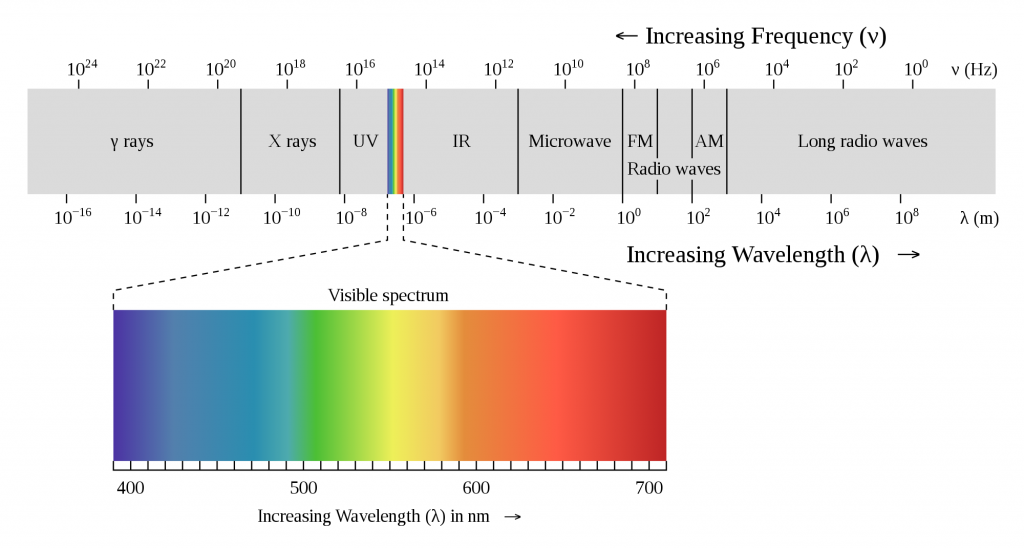 Figure Figure 3.6 The electromagnetic spectrum
Figure Figure 3.6 The electromagnetic spectrum
The retina contains photoreceptors sensitive to a very narrow range of wavelengths, approximately 400 nm (violet) to 700 nm (red). The retinal surface includes two types of photoreceptors called rods and cones based on their shape. Rods are very sensitive to light and serve as the basis for vision in the dark, however visual acuity is poor in comparison to during daylight. Since rods are monochromatic (i.e., respond to only one color) and the information cannot be combined with information from cone receptors, very limited color perception is possible in the dark. There are three types of cones activated during daylight, each enabling perception of color on limited sections of the visible part of the electromagnetic spectrum: those responding to short (bluish), medium (greenish), and long (reddish) wavelengths (see Figure 3.7).
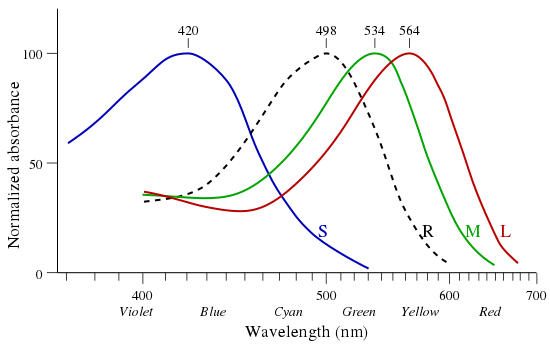
Figure 3.7. Rods and cones
The trichromatic theory of color vision, first advanced by Young (1802) and elaborated upon by Helmholtz (1850), proposes that all the colors humans perceive result from combinations of the outputs of photoreceptors for three primary colors (see Ypu Tube video). It was not until a century later that existence of the three types of cone cells was confirmed (Svaetichin, 1956), providing support for trichromatic theory.
Hering (1892) challenged trichromatic theory based on the observation that it does not seem possible to combine certain colors. There is no problem imagining reddish-orange, yellowish-green, or greenish-blue, but one cannot imagine reddish-green or bluish-yellow. For this reason, Hering proposed the opponent-process theory of color vision. The theory proposes that there is an achromatic (i.e., without color) brightness system and a color system based upon the combined results of red-green and blue-yellow opponent channels. Stimulation of one of the colors of an opponent pair is presumed to inhibit perception of the other. This is how the theory explains the inability to combine red and green or blue and yellow. Another phenomenon that can be explained by opponent-process theory but not the trichromatic theory is the negative afterimage (see Figure 3.8). Stare at the word “afterimage” in the center of the rectangle below for 30 seconds. If you then shift your gaze to a white surface you will see the letters and background comprised of the compliments of the original colors. This is what would be expected if the initially activated component of a red-green or blue-cell system became fatigued. The result would be an illusion consisting of the complementary color.

Figure 3.8 Negative afterimage.
We now know that whereas the trichromatic theory of color vision is correct at the level of the cones, the opponent-process theory is true at later stages of processing in bipolar cells on the way to the optic nerve (see Figure 3.8).

Figure 3.9 Opponent-process retinal receptor cells
Adapting to the Dark
Figure 3.9 shows the change in threshold intensity (i.e., the amount of light needed) to see in the dark over time for rods and cones. The cones are much more sensitive to light during the first five minutes but do not increase in sensitivity beyond ten minutes. Dark adaptation continues to improve with the trajectory for the rods leveling off after another ten minutes. This produces the scallop in the figure labeled the rod-cone break.
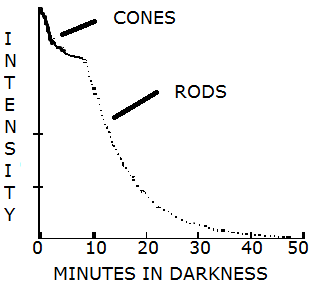
Figure 3.10 Dark adaptation
Hearing and other Senses
Hearing
The exhilarating ripple of her voice was a wild tonic in the rain.
Scott Fitzgerald, The Great Gatsby
Humans rely heavily on hearing as well as vision to survive and enjoy our surroundings. Sound can help us detect the presence of and locate objects which are at great distances or out of sight. Speech communication relies on the ability to hear. If you are similar to most college students, you spend a considerable amount of time listening to music. As expressed by Fitzgerald, the voice of a loved one can soothe and exhilarate us.
Our ears detect and process the vibrations produced by sound waves. When graphed, the amplitude (loudness) of a sound is indicated by the height from top to bottom of a wave cycle. The pitch (low bass vs. high treble) is a function of the frequency of waves per unit of time (see Figure 3.11).
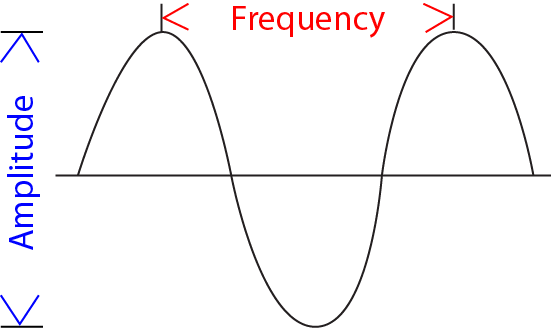
Figure 3.11 Amplitude and frequency of sound waves.
Loudness is measured in decibels. Figure 3.12 shows the decibel levels of some common events. Please be careful about exposing yourself to loud sounds. It is possible to permanently damage your hearing by prolonged exposure to loud music, whether at concerts or when listening with headphones.
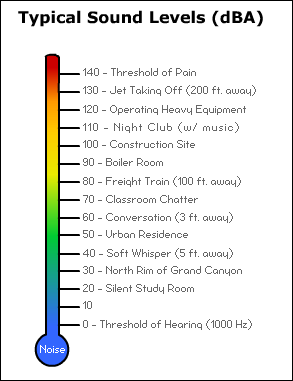
Figure 3.12 Decibel Levels of Common Events.
Figure 3.13 shows the major parts of the ear involved in the transduction process converting sound waves into electronic signals transmitted to the brain, primarily the temporal lobe of the cerebral cortex.
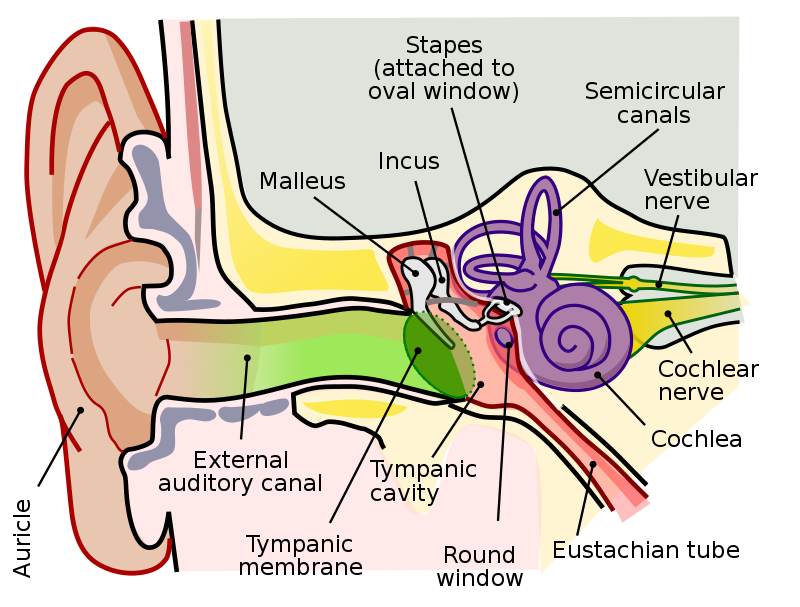
Figure 3.13 Anatomy of ear (brown is outer ear, red is middle ear, purple is inner ear).
The ear can be divided into outer, middle, and inner parts. The outer ear includes the ear flap, ear canal, and eardrum. The middle ear is in an enclosed chamber behind the eardrum and includes the three tiniest bones (ossicles) in the body often described as the hammer, anvil, and stirrup. The inner ear consists of the cochlea, a snail shaped tube filled with fluid. When sound waves reach the eardrum they cause it to vibrate. These vibrations are amplified by the ossicles and transmitted to the cochlea. The limits of human hearing are determined by the nature of tiny hair cells contained within the basilar membrane lining the cochlea (see Figure 3.14). Starting at the end (apex) of the cochlea, the hair cells are responsive to increasing frequencies of sound waves. Human hearing extends approximately from 20 to 20,000 Hz (vibration cycles per second). The neural information from the basilar membrane is transmitted to the auditory nerve and then to the brainstem.
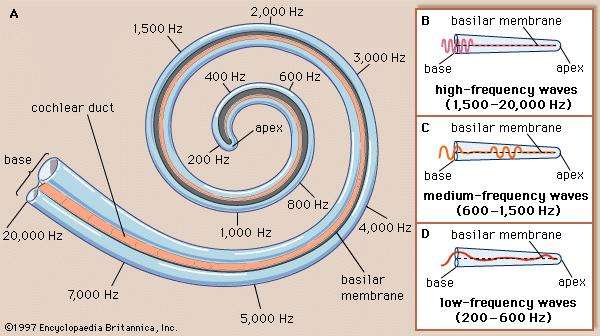
Figure 3.14 The cochlea.
Smell and Taste
One of the very nicest things about life is the way we must regularly stop whatever it is we are doing and devote our attention to eating.
Luciano Pavarotti and William Wright, from Pavarotti, My Own Story
Figure 3.15 portrays the different cells for salty (Type I), sweet, umami (flavor of glutamates) and bitter (Type II), and sour (Type III) tastes. Figures 3.16 and 3.17 show the neural pathways for the senses of taste and smell. The surfaces (epithelium) of the nasal passage and tongue contain receptors sensitive to specific odors and tastes. Stimulation of the smell and taste receptors transmit signals terminating in the temporal lobe of the cerebral cortex. The senses of smell and taste are not as fundamental to human survival as vision and hearing. Still, they play an important adaptive role in the identification of poisonous foods and chemicals. Eating is also one of the basic pleasures of life. Smell and taste work in concert in helping us discriminate flavors and enjoy the spices of life.
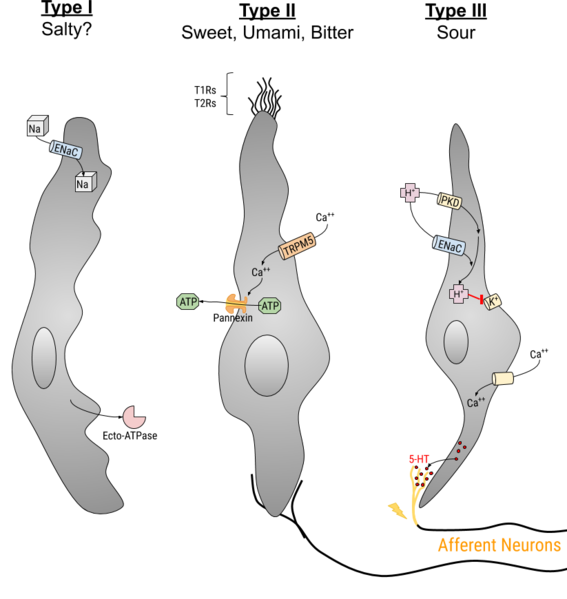
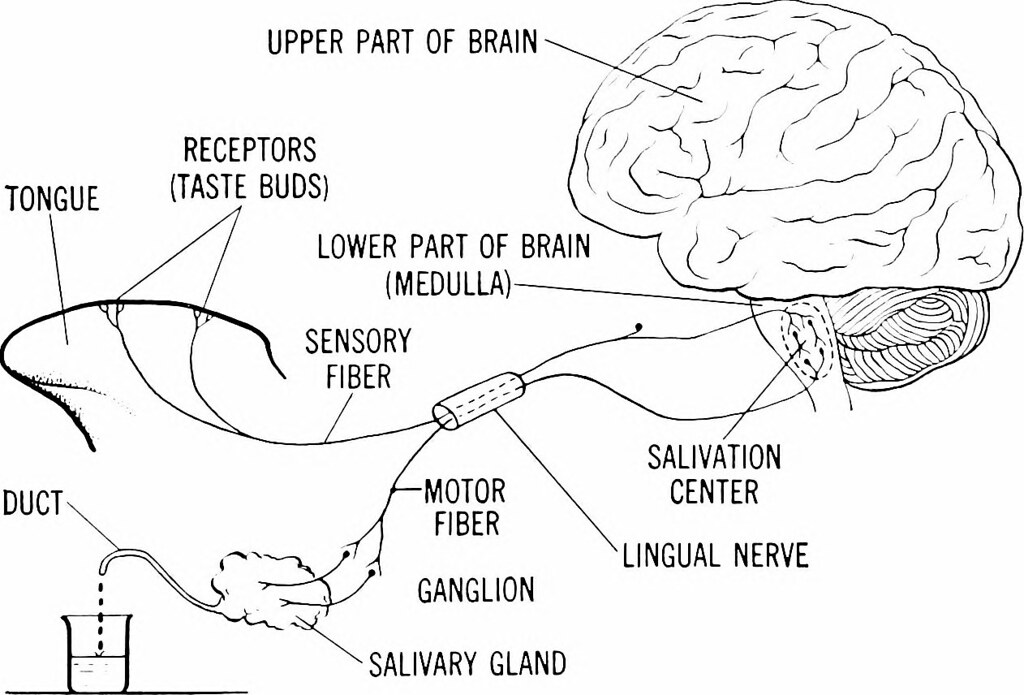
Figures 3.15 and 3.16 Neural cells and pathway for sense of taste.
Figure 3.17 Neural pathway for sense of smell.
Touch, Temperature and Pain
Figure 3.18 portrays the different specialized skin receptors for touch, temperature, and pain. Information from these receptors is relayed to the primary somatosensory area of the parietal lobe in the central cortex.
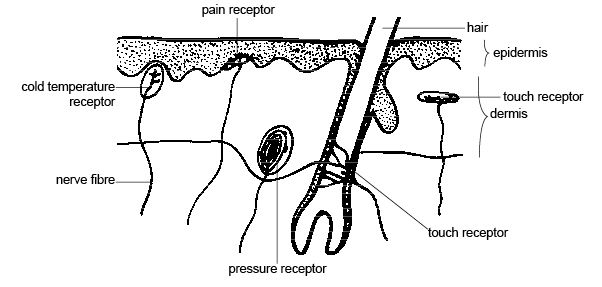
Figure 3.18 Skin receptors for touch, temperature, and pain.
Two-point discrimination thresholds for the sense of touch vary according to the amount of brain space dedicated to the body part in the somatosensory cortex (see Figure 2.2). The fingertips and lips which have disproportionate amounts of brain space are the most sensitive areas, typically requiring only 2-4 mm for one to be able to report being touched in two different spots. In comparison, it might take from 10-15 mm on the palm of one’s hand or 30-40 mm on one’s back to detect being touched in two different spots.
Sherrington (1906) was the first to demonstrate that certain types of intense stimulation could elicit reflexive responses and responses by the autonomic nervous system along with the sensation of pain. When a high threshold is reached for mechanical (intense pressure or injured tissue), thermal (extreme heat or cold), or chemical (toxins) stimulation, a neural signal is transmitted to the central nervous system. A stimulus likely to result in injury will elicit a withdrawal reflex at the level of the spinal cord within half a second (see Figure 3.19).

Figure 3.19 Spinal reflex arc.
Balance and Muscle Tension
Animals, including human beings, are able to perform amazing feats of balance. These feats require coordination between the vestibular system in the ears, the eyes, and proprioception (i.e., sense of muscle location and movement). Attached to the cochlear in the inner-ear (see Figure 3.12) is a pretzel-like structure called the semi-circular canals. The three circles are filled with fluid and contain hair cells which respond to the position of and speed of movement of the head in three-dimensional space. This information is transmitted to the thalamus and parietal lobe of the cerebral cortex. There it is combined with information obtained through the eyes regarding the body’s position in space and sensors of the muscles and joints. Integration of this information enables us to maintain our balance while stationary or in motion.
A common test to determine whether your proprioceptive sense is functioning properly is to see if you can touch the tip of your nose with your eyes closed. This would only be possible if you are receiving accurate non-visual information regarding the location of your body parts (see Figure 3.20).
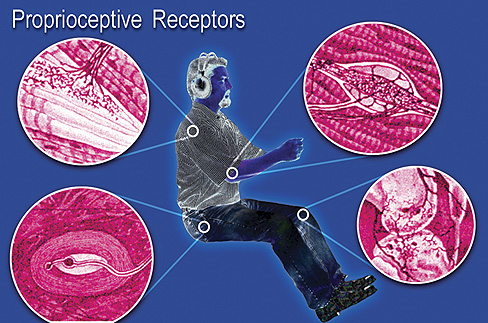
Figure 3.20 Proprioceptive receptors.
Sensation and Human Potential
Our senses helped humans to survive on earth under very different geographic and climatic conditions for tens of thousands of years. For practically all of this time we lived as nomadic hunter-gatherers. It is only within the past 11,000 years that domestication of plants (i.e., agriculture) and large animals permitted production of sufficient food surpluses to remain in one location (Diamond, 2005). This eventually led to establishing larger and larger social units, starting with bands and tribes, eventually becoming chiefdoms and states (Diamond, 2012). Recalling the picture of Manhattan, it is only within the past 400 years that the scientific method has resulted in technologies substantially transforming the human condition. Prior to then, we adapted to the environmental conditions under which we biologically evolved. Now we must adapt to a human-constructed environment. This technology-enhanced world frees us from dedicating our lives to fulfilling basic survival needs. We are able to contribute to our social units in an increasing variety of ways. At the same time, technologies have resulted in dangers for which we are not genetically prepared. Some of these dangers result from limitations of our senses. For example, industrialization resulted in production of carbon monoxide, a gas which did not previously exist on earth. Humans cannot smell carbon monoxide, resulting in many accidental deaths from exposure.
Technological enhancements of our senses (primarily vision) were essential to much of the progress occurring over the past 400 years. It is common to refer to Galileo when discussing the beginning of the scientific revolution. One of the ways in which sciences progress is by developing instruments permitting the observation of new natural events. Galileo used a telescope to discover four of Jupiter’s moons. The observation that these moons revolved around Jupiter and not the earth was inconsistent with the prevalent belief that the earth was the center of the universe. Although extremely controversial at the time, it is now impassionately accepted that the earth revolves around the sun rather than the other way around. Key to Galileo’s observations and conclusions was the ability to see objects not visible to the naked eye. Much of the scientific knowledge acquired since Galileo’s time has required similar enhancements of our senses. Examples include the microscope and amplification of sound. It is fascinating to consider the possibilities for enhancement of human senses and performance along with the ethical implications (Khushf, 2005).
Perception and Human Potential
The beginning of human knowledge is through the senses, and the fiction writer begins where human perception begins.
Flannery O’Connor
Perception – Interpreting Stimuli
We have completed consideration of the stimulation processed through Aristotle’s five major senses along with balance and movement. At this point the body has received input that something has happened in an exclusively bottom-up process. With the exception of painful stimuli posing immediate danger triggering a spinal withdrawal response, sensory information is relayed to the brain for further processing.
Not all environmental stimulation relates to survival or achievement of one’s goals. Adapting to one’s environment requires interpretation and prioritization. Once an event is detected, it is important to determine where it originated and what it is. One way the brain has evolved to interpret and prioritize sensory input is the development of feature detectors (Hubel and Wiesel, 1959, 1962). These are cells in the visual cortex which respond to stimuli likely to convey adaptive information. Specialized cells have been discovered for movement, lines, edges, and angles. These characteristics are frequently associated with biologically significant stimuli. For example, movement might signal the presence of a predator. Lines and edges could signal the presence of solid stationary objects or a sudden drop off in height. As shown in Figure 3.21, even infants and other animals are cautious upon approaching a visual cliff (Gibson and Walk, 1960).
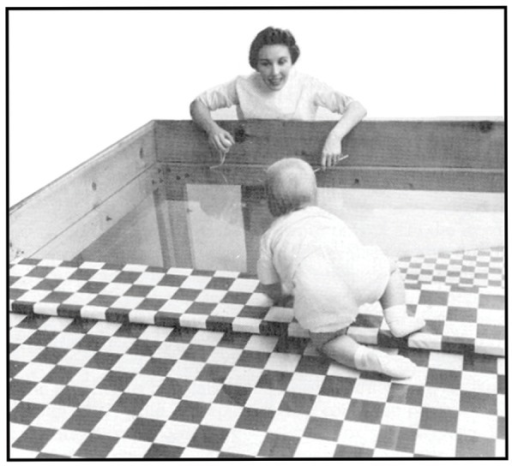
Figure 3.21 The visual cliff.
Depth Perception
The ability to perceive depth (the relative location of objects) and distance (how far objects are from you) in three-dimensional space is essential to survival and responsible for the visual cliff. In addition to feature detectors for edges and lines, there are additional visual cues which facilitate depth perception. Some of these are dependent on the information obtained from both of our eyes (i.e., binocular cues) whereas others are based upon the information available to one eye (i.e., monocular cues). Not all animals with two eyes have them located so that they are facing in the same direction (e.g., fish). When both eyes face forward there is overlap as well as differences in the visual fields providing potential information regarding the location of objects. The human visual field covers approximately 200 degrees of which there is 120 degrees of overlap between the two eyes.
The major binocular cues are retinal disparity and convergence. Retinal disparity results from your eyes being separated in space, producing stimulation from slightly different angles. The stimulation from objects which are far away is much more similar for both eyes than the stimulation from close objects. Similarly, your two eyes converge (i.e., move closer to each other) as objects move closer. This provides depth and distance information from the muscles controlling eye movements.
It is counter-intuitive but most of the cues related to perceiving objects as three-dimensional are monocular and two-dimensional. Artists take advantage of such cues in creating realistic images. The major monocular cues are linear perspective, occlusion (interposition), textual gradient, relative size, size familiarity and position relative to the horizon (Figure 3.22).

Figure 3.22 Monocular depth cues.
Gestalt Principles of Perceptual Organization
As described in Chapter 1, the Gestalt psychologists believed that perception was primarily a top-down process involving meaningful units rather than a bottom-up process combining elements of sensation. Only a process including the effects of prior experience could meaningfully interpret often ambiguous sensory information. Determination of what constitutes the figure and ground in an image provides an example. The images in Figures 3.23 and 3.24 may be perceived in two ways. The first may be perceived as either a black vase on a white background or two white heads facing each other on a black background. The second image may be seen as either a saxophone player on a white background or a face on a black background. Ordinarily you will see one of the two possibilities and not the other. Once informed of the other possibility one may cycle back-and-forth between the two perceptions demonstrating the impact of prior experience upon the organization and interpretation of sensations. Another way of influencing interpretation of an ambiguous image is to establish a perceptual set through exposure to conceptually related images or words. For example, if you first saw pictures of a table and a chair, or read the words “table” and “chair”, you would be more likely to perceive the vase than the faces. If you saw pictures of an arm and leg or read the words, you would be more likely to perceive the faces. The establishment of a perceptual set is a clear cut example of top-down processing of sensory information.

Figure 3.23 and Figure 3.24 Faces or vase? Saxaphone player or woman?
Another example of top-down processing involving prior experience is perceptual constancy. This refers to the fact that an object’s shape and size is perceived as remaining constant despite differences in orientation and location (see Figure 3.25).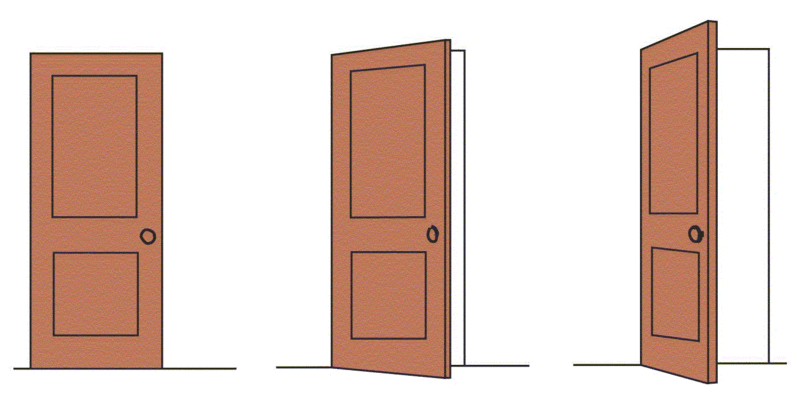
Figure 3.25 Constancy of shape and size.
The Gestalt psychologists proposed several principles to account for the organization and perception of groups comprised of ambiguous elements. Their major principles include proximity (Figure 3.26), similarity (Figure 3.27) and closure (Figure 3.28). You are likely to perceive the first drawing as consisting of alternating blue and black rows, the second as pairs of lines in three columns, the third as four curved lines consisting of four dots and the fourth as a complete circle and square.
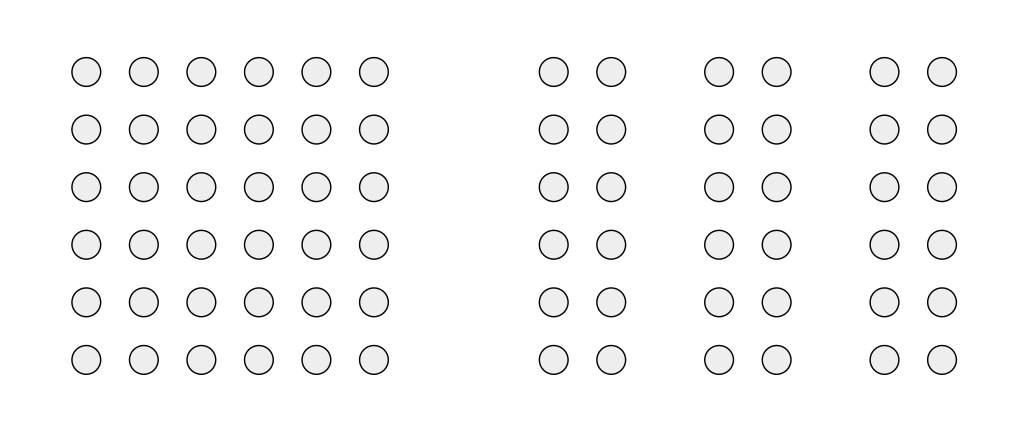


Figures 3.26 – 3.28 Principles of proximity, similarity and closure.
Learning to read is an excellent example of the importance of Gestalt principles. Reading may be described as a sequence of steps establishing larger and larger meaningful units (i.e., gestalts). Eye-movement recordings reveal that individual letters are not initially perceived as units. With increased experience, we are able to integrate the components into a relatively small number of distinct letters followed by integration of letters into words. It has recently been demonstrated that we perceive the letters of words simultaneously (i.e., as a “gestalt”) not sequentially (Adelman, Marquis, and Sabatos-DeVito, 2010). Eventually, we are able to read aloud fluently by scanning phrases and sentences (Rayner, 1998). The role played by experience and top-down processing in the interpretation of letters is exemplified by the ambiguous second letters below. The first letter is usually perceived as an “H” and the second as an “A” (Figure 3.29).

Figure 3.29 Gestalt principles of perceptual organization and reading.
Arguably, reading is the most important skill one can acquire to adapt to the modern human condition. We describe the elementary-school experience as emphasizing the three “R”s (reading, “riting” and “rithmatic.” “Reading is fundamental” in that it is essential to learning to write and acquiring quantitative concepts. The importance of reading will be considered further in Chapters 6 (Indirect Learning) and 8 (Developmental Psychology).
College As Education of your Senses
As described in Chapter 1, the college curriculum is designed to help you develop different perspectives with which you can understand and appreciate your life. Usually undergraduates take a course in art, music, or both. Such courses might be considered “education of the senses.” The fact that even bands of nomadic hunter-gatherers produce art and music suggest that there is something about our genetics which makes such activities intrinsically rewarding. In Chapter 4, we will discuss the role of motivation and emotion in realizing our potential as individuals and a species. Certainly, a developed appreciation of the different forms of human creativity enhances and enriches our lives.
College courses in art and music expose students to classic and current forms of human creativity. In the same way that reading requires constructing larger and larger “gestalts” (i.e., letters, words, phrases, sentences, etc.), the same can be true for art (lines, shapes, forms, patterns, etc.) and music (e.g., tones, chords, melodies, etc.). Your eyes and ears can be “trained” to detect elements and patterns of visual and auditory sensations. Courses in art and music analyze (i.e., determine the common elements of “good” art and music) and synthesize (i.e., relate different examples of art and art forms to each other) the creative and performing arts. In this way, such courses convey our current understanding of those defining human qualities which do not at first glance appear related to eating and surviving but rather to “What’s it all about?”
There is a saying that you get out of life what you put into it. The amount of time and effort you dedicate to any activity will influence how proficient you become. This applies to your schoolwork and grades, but the college experience provides other possibilities for developing your potential. There are usually many extra-curricular activities available for you to sustain existing hobbies and interests and explore new ones. At the end of the next chapter, I will describe a strategy for objectively describing your current self and ideal self. This will provide an opportunity to engage in soul-searching concerning the knowledge, skills, and attitudes you would like to acquire in your immediate and long term future. For now, I will restrict the discussion to activities related to sensation and perception. Colleges and universities frequently have clubs or activities dedicated to art (vision), music (hearing), food and/or wine tasting (taste and smell), dance and gymnastics (balance). There are often offices or campus units where you can obtain paid or voluntary positions requiring specialized applications of your senses. This would certainly be true if you worked as an artist for a campus newspaper or as a DJ for a college radio station. There is an old saying that there are three types of people: those who make things happen, those who watch things happen, and those who ask, “What happened?” In the same way that it is important to be an active student by trying to anticipate and answer questions based upon your course material, it is important to be active in your personal development during your college years. Try to explore your college environment, searching for growth opportunities. Try out and join interesting clubs. Attend special lectures and events. Make things happen!
Things do not happen. Things are made to happen.
John F Kennedy
Self-Control Projects to Educate your Senses
At the end of Chapter 1, I listed several recent self-control projects conducted by my students. Scattered among them were projects designed to increase and improve drawing and piano playing. As an example of how the psychology research literature can assist you in achieving your personal objectives, an experiment was conducted to compare two different approaches to learning to play the piano. It was found that practicing with both hands at the same time was better and more efficient than practicing with one hand at a time (Brown, 1933).
The psychology research literature can also play a valuable role in your self-control project. One of the skills a professional in any field must possess is the ability to locate and evaluate research. We live in a time in which we are inundated with information from the media and the internet. Reviewing the literature can feel like searching for a needle in a haystack. Even when you think you have located relevant information, how can you be certain you can trust the source? Fortunately, most professions attempt to facilitate this process by developing peer-evaluated databases. The American Psychological Association produces PsycINFO, which lists and abstracts peer-reviewed articles dating from the 1800s. In addition to psychology research, PsycINFO covers related fields such as medicine, neuroscience, and social work. Most college libraries will have a subscription to this extremely helpful and credible database.
